Indian cuisine
| This article is part of the series on |
| Indian cuisine |
|---|
 |
| Part of a series on the |
| Culture of India |
|---|
 |
The cuisine of India encompasses a variety of regional cuisines making use of local spices, herbs, vegetables, and fruits. Indian religious and cultural habits—especially Hindu beliefs and culture—have shaped the development of these cuisines. Vegetarianism is common in Indian society.[1] Indian cuisine has evolved as a result of the subcontinent's cultural interactions with other societies.[2][3] Indian cuisine has also shaped the history of international relations; the spice trade between India and Europe is often cited as the primary catalyst for Europe's Age of Discovery.[4] Indian cuisine has influenced other cuisines across the world, especially those from Southeast Asia, the British Isles and the Caribbean.[5][6]
History
Indian cuisine has been influenced by a 5000-year history of various groups and cultures interacting with the subcontinent, leading to the diversity of flavors and regional cuisines found in modern-day India.
Antiquity
Many recipes first emerged during the initial Vedic period, when India was still heavily forested and agriculture was complemented with game hunting and forest produce. In Vedic times, a normal diet consisted of fruit, vegetables, grain, dairy products, honey, and meat, especially poultry. Over time, some segments of the population embraced vegetarianism. The advent of Buddhism affected this shift, as well as an equitable climate permitting a variety of fruits, vegetables, and grains to be grown throughout the year. A food classification system that categorized any item as saatvic, raajsic or taamsic developed in Ayurveda. The Bhagavad Gita prescribes certain dietary practices (Chapter 17, Verses 8-10).[7] In this period, consumption of beef became taboo; many Indians continue to abide by this belief, making the use of beef in Indian cuisine rather rare.
Middle Ages
During the Middle Ages, several North Indian dynasties were predominant, including the Gupta dynasty. Travelers who visited India during this period introduced new cooking methods and products to the region, such as tea and spices. Later, Northern India was invaded by Central Asian cultures, which led to the emergence of Mughlai cuisine, a mix of Indian and Central Asian cuisine. Hallmarks of this cuisine include several seasonings, such as saffron, and the practice of cooking in a sealed pot called a dum.
Ingredients

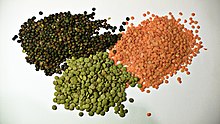
Staple foods of Indian cuisine include pearl millet (bajra), rice, whole-wheat flour (atta), and a variety of pulses, especially masoor (most often red lentils), channa (bengal gram), toor (pigeon pea or yellow gram), urad (black gram), and moong (green gram). Pulses may be used whole, dehusked—for example, dhuli moong or dhuli urad—or split. Split pulses, or dal, are used extensively. Some pulses, such as channa and mung, are also processed into flour (besan).
Many Indian dishes are cooked in vegetable oil, but in northern and western India, peanut oil is popular, and in eastern India, mustard oil is more commonly used. Coconut oil is used widely along the western coast, especially in Kerala; gingelly (sesame) oil is common in the south as well. In recent decades, sunflower and soybean oil have become popular across India. Hydrogenated vegetable oil, known as Vanaspati ghee, is another popular cooking medium. Butter-based ghee, or desi ghee, is used frequently, though less than in the past.
The most important or frequently used spices in Indian cuisine are chilli pepper, black mustard seed (sarso), cumin (jeera), turmeric (haldi), fenugreek (methi), asafoetida (hing), ginger (adrak), coriander (dhania), and garlic (lehsun). One popular spice mix is garam masala, a powder that typically includes five or more dried spices, especially cardamom, cinnamon, and clove. Each culinary region has a distinctive garam masala blend—individual chefs may also have their own. Goda masala is a comparable, though sweet, spice mix popular in Maharashtra. Some leaves commonly used for flavoring include bay (tejpat), coriander, fenugreek, and mint leaves. The use of curry leaves and roots is typical of Gujarati and South Indian cuisine. Sweet dishes are often seasoned with cardamom, saffron, nutmeg, and rose petal essences.
Regional cuisines
Cuisine differs across India's diverse regions as a result of variation in local culture, geographical location (such as whether a region is close to sea, desert, or mountains), and economics. It also varies seasonally, depending on which fruits and vegetables are ripe.
Andaman and Nicobar Islands
Seafood plays a major role in the cuisines of the Andaman and Nicobar Islands. Since the indigenous Andamanese traditionally had very little contact with the outside world, raw fish and fruits have long been a staple diet for them. Immigrated from other regions of India, however, has resulted in variations in the cuisine.
Andhra Pradesh
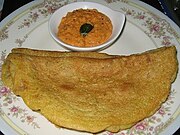
Cuisine of the southern state of Andhra Pradesh is referred to as Telugu and Hyderabadi cuisine. Rice is the staple starch and is usually consumed with a variety of curries and lentil soups or broths. Although much of the region's population are vegetarians, the coastal areas are known for their seafood dishes. Food in Andhra Pradesh is known for heavy usage of spices and chillies. One of the most important parts of the local cuisine is the use of various pickles, such as avakaya, a pickle made from green mango, and gongura, a pickle made from red sorrel leaves. Curds are a common addition to meals, as a way of neutralizing spiciness. Another popular regional dish is Hyderabadi biryani, a mixture of rice, yogurt, onions, meat, and spices. The biryani is derived from the Persian style of slow cooking. While only a small proportion of the Hyderabad populace are vegetarians, vegetarian food is still quite popular, and is often served for breakfast and lunch. Breakfast items like dosa, vada have origins in Udipi, Karnataka but are influenced by spices native to Andhra Pradesh.
Arunachal Pradesh
The staple food of Arunachal Pradesh is rice, along with fish, meat and green vegetables. Many varieties of rice are used. Lettuce is the most common vegetable, usually prepared by boiling with ginger, coriander and green chillies. Boiled rice cakes wrapped in leaves are a popular snack. Thukpa is a kind of noodle soup common among the Monpa tribe of the region.
Assam
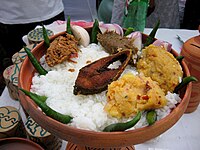
Assamese cuisine is a mixture of different indigenous styles, with considerable regional variation and some external influences. Although it is known for its limited use of spices, Assamese cuisine has strong flavors from its use of endemic herbs, fruits, and vegetables served fresh, dried, or fermented. Fish is widely eaten, as are birds, such as duck or pigeon. The region's cuisine involves simple cooking processes; the practice of bhuna, the gentle frying of spices before the addition of the main ingredients, generally common in Indian cooking, is absent in the cuisine of Assam. A traditional meal in Assam begins with a khar, a class of dishes named after the main ingredient, and ends with a tenga, a sour dish. The food is usually served in bell metal utensils. Pann, the practice of chewing betel nut, generally concludes a meal.
Bihar


The cuisine of Bihar, a part of North Indian cuisine, shares many similarities with neighboring West Bengal and Orissa. Bihari society is not strictly vegetarian, but people often avoid eating meat regardless. Bihari people typically eat boiled rice and daal with cooked vegetables for lunch, and roti with cooked vegetables for dinner—roti and boiled rice are rarely eaten together. Due to this area's joint Hindu-Muslim heritage, river fish, chicken, and goat meat are popular meats, eaten maily with boiled rice. Fish curry is made using mustard paste, a similar technique to the Oriya way of cooking fish. Dairy products, such as yogurt (dahi), buttermilk (mattha), butter, ghee (clarified butter), and lassi, are consumed throughout the year. The Champaran region is famous for a grilled mutton dish called taash. Watery foods, such as watermelon and sherbet made of pulp of the wood-apple fruit, are consumed mainly in the summer months, and dry foods and preparations made of sesame or poppy seeds mainly in the winter months. Roti soaked in milk is common, and there is a custom of eating flattened rice (poha) with yogurt and sugar. Bihar is famous for sattu parathas (parathas stuffed with fried chickpea flour), spicy mashed potatoes (chokha), fish curry, litti, Bihari kebab, and postaa-dana kaa halwaa. Another common dish is alu-bhujia, made from potatoes cut like French fries and cooked in mustard oil and mild spices, and eaten with roti or rice and daal. Tangy raita made from winter melon (lauki) or unripened papaya, yogurt, and spices, and often a paste of green chilli, ginger, garlic and mustard, is popular in many parts of Bihar.
Chattisgarh
Chattisgarh cuisine uses many foods not found in the rest of India, although the staple food is rice, like in much of the country. Many Chattisgarhi people drink liquor brewed from the Mahuwa flower. The tribal people of the Bastar region of Chhattisgarh eat whatever is available, including food which would not be eaten by people of other states and regions, such as red ant chutney. Flying ants, mushrooms, squirrels, and rats are considered delicacies, but fish and pork constitute a large part of Chhatisgarhi cuisine. Almost every major ceremony in the region begins with the sacrifice of a pig.[8]
Daman and Diu
Daman and Diu is a union territory of India which, like Goa, was a former colonial possession of Portugal. Consequently, both native Gujarati food and traditional Portuguese food are common. As the neighbouring state of Gujarat has prohibited alcohol, drinking is common in Daman and Diu, and almost all popular brands of foreign liquor are readily available.[9][10]
Goa


The area is located in a tropical climate, and spices and flavors are intense. Use of kokum is a distinct feature of the region's cuisine. Goan cuisine is mostly seafood based; the staple foods are rice and fish. Kingfish (Vison or Visvan) is the most common delicacy, and others include pomfret, shark, tuna, and mackerel; these are often served with coconut milk. Shellfish, including crabs, prawns, tiger prawns, lobster, squid and mussels are commonly eaten. The cuisine of Goa is influenced by its Hindu origins, four hundred years of Portuguese colonialism, and modern techniques. Frequent tourism in the area gives Goan food has an international aspect. Goan Saraswat Brahmin and Daivajna Brahmins eat fish and chicken most of the time, occasionally observing vegetarianism for religious reasons, although Brahmins belonging to Pancha Dravida are strict vegetarians.
Gujarat

Gujarati cuisine is primarily vegetarian. The typical Gujarati thali consists of roti (rotli in Gujarati), daal or kadhi, rice, and sabzi/shaak, a dish of different combinations of vegetables and spices which may be stir fried, spicy or sweet). Gujarati cuisine can vary widely in flavor and heat based on personal and regional tastes. North Gujarat, Kathiawad, Kachchh, and South Gujarat are the four major regions of Gujarati cuisine. Many Gujarati dishes are simultaneously sweet, salty, and spicy. In mango season keri no ras (fresh mango pulp), is often an integral part of the meal. Spices also vary seasonally; garam masala is used less in summer, for example. Regular fasting, with diets limited to milk, dried fruit, and nuts, is a common practice.
Haryana

Cattle are common in Haryana, so dairy products are a common component of its cuisine. Specific dishes include kadhi pakora, besan masala roti, bajra aloo roti, churma, kheer, Bathua raita, methi gajar, singri ki sabzi, and tamatar chutney.
Lassi and sherbet are two popular non-alcoholic beverages in Haryana. Liquor stores are common there, which cater to the traffic of many truck drivers.[11][12]
Himachal Pradesh
The daily diet of Himachalis is similar to that of the rest of North India, including lentils, broth, rice, vegetables, and bread, although non-vegetarian cuisine is preferred. Some of the specialities of Himachal include pateer, chouck, bhagjery and til chutney.
Jammu & Kashmir

Kashmiri cuisine has evolved over hundreds of years. Its first major influence was the food of the Kashmiri Hindus and Buddhists. The cuisine was later influenced by the cultures which arrived with the invasion of Kashmir by Timur from the area of modern Uzbekistan. Subsequently influences have included the cuisines of Central Asia, Persia, and the North Indian plains. The most notable ingredient in Kashmiri cuisine is mutton, of which there are over 30 varieties.
Kashmiri Pandit food is elaborate, and an important part of the Pandits' ethnic identity. Kashmiri Pandit cuisine usually uses yogurt, oils, and spices as such turmeric, red chilli powder, cumin, ginger, and fennel, though they do not use onion and garlic.[13]
Jharkhand
Traditional Jharkhandi dishes are not available at the restaurants, as they have not been commercialised. Prepared exclusively in tribal regions, this cuisine uses oil and spices infrequently, except for pickle production and special occasions.
Karnataka

Varieties in the cuisine of Karnataka reflect influences from the three neighbouring South Indian states, as well as the states of Maharashtra and Goa to the north. Typical dishes include bisi bele bath, jolada rotti, chapati, ragi rotti, akki rotti, saaru, huli, vangibath, khara bath, kesari bath, Benne Dose, ragi mudde, and uppittu. The Kodagu district is famous for spicy pork curries, while coastal Karnataka specializes in seafood. Although the ingredients differ regionally, a typical Kannadiga Oota (Kannadiga meal) is served on a banana leaf. The coastal regions of Mangalore and Udupi have slightly varying cuisines, which make extensive use of coconut in curries and frequently include seafood.
Kerala
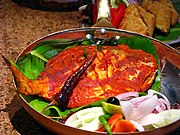
Kerala cuisine blends indigenous dishes with foreign ones adapted to local tastes. Coconuts grow in abundance in Kerala, so grated coconut and coconut milk are commonly used for thickening and flavouring. Kerala's long coastline and numerous rivers have led to a strong fishing industry in the region, making seafood common. Rice is grown in abundance; along with tapioca it is the main starch ingredient used in Kerala's food. Having been a major production area of spices for thousands of years, the region makes frequent use of black pepper, cardamom, clove, ginger, and cinnamon. Most of Kerala's Hindus, except its Brahmin community, eat fish, and non-vegetarian foods are common, like Chicken, Beef, Pork catering to Kerala's large minorities of Muslims and Christians. In most Kerala households, a typical meal consists of rice, fish, and vegetables. Kerala also has a variety of breakfast dishes like idli, dosa, appam, idiyappam, rasam, puttu, and pathiri.
Lakshadweep
The culinary influence of Kerala is quite evident in the cuisines of Lakshadweep, since the island lies in close proximity to Kerala. Coconut and sea fish serve as the foundations of most meals. The people of Lakshadweep drink large amounts of coconut water, the most abundant aerated drink on the island.[14]
Madhya Pradesh
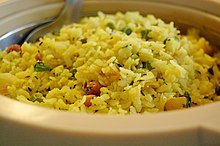
The cuisine in Madhya Pradesh varies regionally. Wheat and meat are common in the north and west of the state, while the wetter south and east are dominated by rice and fish. Milk is a common ingredient in Gwalior and Indore. The street food of Indore is renowned, with shops that have been active for generations. Bhopal is known for meat and fish dishes, such as rogan josh, korma, keema, biryani, pilaf, and kebabs. There is street named "Chatori Gali" in old Bhopal where one can find traditional Muslim non-veg fare like Paya Soup, Bun Kabab, Nalli-Nihari to name a few local specialities.
Dal bafla is a common meal in the region, consisting of a steamed and grilled wheat cake dunked in rich ghee which is eaten with daal and ladoos. The culinary specialty of the Malwa region of central Madhya Pradesh is poha (flattened rice); usually eaten at breakfast with jalebi.
Beverages in the region include lassi, beer, and rum and juice made from sugarcane. A local liquor is distilled from the flowers of the mahua tree, and date palm toddy is also popular. In tribal regions, a popular drink is the sap of the sulfi tree, which may be alcoholic if it has gone through fermentation.[15]
Maharashtra


Maharashtrian cuisine includes a range of dishes from mild to very spicy tastes. Bajri, wheat, rice, jowar, vegetables, lentils, and fruit form important components of the Maharashtrian diet. Popular dishes include puran poli, ukdiche modak, batata wada and wada pav. The cuisine of Maharashtra can be divided into two major sections–the coastal and the interior. The Konkan, on the coast of the Arabian Sea has its own type of cuisine, a homogeneous combination of Malvani, Gaud Saraswat Brahmin, and Goan cuisines. In the interior of Maharashtra, the Vidarbha area has its own distinctive cuisine.
Apart from Konkan, the state's cuisine uses ground nuts, jaggery, wheat, jowar and bajra extensively. A typical meal consists of rice and bread both along with varan and aamtee—lentils and spiced vegetables. Like other coastal states, there is an enormous variety of vegetables eaten, and fish and coconuts are common. Peanuts and cashews are often served with vegetables. Grated coconuts are used to flavor many types of dishes, but coconut oil is not widely used; peanut oil is preferred. Kokum, most commonly served chilled in an appetizer-digestive called sol kadhi, is prevalent. During summer, Maharashtrians consume panha, a drink made from raw mango is consumed.
Manipur
Manipuri cuisine typically features spicy foods that use chilli pepper rather than garam masala. The staple diet consists of rice, leafy vegetables, and fish.[16] Manipuris typically raise vegetables in kitchen gardens and rear fish in small ponds around their homes. The Umarok is a very popular chili in the area, also known by names such as naga jolokia or "ghost chili" (in US media).[17]
Meghalaya
Meghalayan cuisine is unique, different even from other northeastern Indian states. Spiced meat is common, from goats, pigs, fowl, ducks, and cows. In the Khasi and Jaintia Hills districts, common foods include jadoh, ki kpu, tung-rymbai, and pickled bamboo shoots. Other common foods in Meghalaya include minil songa (steamed sticky rice), sakkin gata, and momo dumplings. Like other tribes in the northeast, the Garos ferment rice beer, which they consume in religious rites and secular celebrations.
Mizoram
The cuisine of Mizoram differs from that of most of India, though it shares characteristics with other cuisines from the northeastern part of the country.[18] Mizo cuisine blends Chinese and North Indian cuisines, offering mainly non-vegetarian delicacies. Dishes may be served on fresh banana leaves. Meals tend to be less spicy than in most of India. A popular dish is bai, made from boiling spinach with pork and bamboo shoots and served with rice.Sawchair is another common dish, made of rice cooked with pork or chicken.[19]
Nagaland

The cuisine of Nagaland reflects that of the Naga people. It is known for exotic pork meats cooked with simple and flavorful ingredients[20], like the extremely hot bhut jolokia pepper, fermented bamboo shoots and soya beans. The Naga use oil sparingly, preferring to ferment, dry, and smoke their meats and fish. Traditional homes in Nagaland have external kitchens that serve as smokehouses.
Orissa


The cuisine of Orissa relies heavily on local ingredients. Flavors are usually subtle and delicately spiced, unlike the spicy curries typically associated with Indian cuisine. Fish and other seafood, such as crab and shrimp, are very popular, and chicken and mutton are also consumed. Panch phutana, a mix of cumin, mustard, fennel, fenugreek, and kalonji (nigella) is widely used for flavoring vegetables and dals, while garam masala and turmeric are commonly used for meat-based curries. Pakhala, a dish made of rice, water, and yogurt, that is fermented overnight, is very popular in summer in rural areas. Oriyas are very fond of sweets, so dessert follows most meals.
Pondicherry
The union territory of Puducherry was a French colony for around 200 years, making French cuisine a strong influence on the area. The influence of the neighboring areas, such as Tamil Nadu, Andhra Pradesh, and Kerala is also visible on the territory's cuisine. Some favorite dishes include coconut curry, tandoori potato, soya dosa, podanlangkai, curried vegetables, stuffed cabbage, and baked beans.[21]
Punjab


The cuisine of Punjab is known for its diverse range of dishes. Home-cooked and restaurant Punjabi cuisine can vary significantly. Restaurant-style Punjabi cooking uses large amounts of ghee, butter, and cream, while home-cooked equivalents center around whole wheat, rice, and other ingredients flavored with masala[22]. Regional differences also exist in Punjabi cuisine. People in the area of Amritsar prefer stuffed paratha and dairy products, for example. Certain dishes are exclusive to Punjab, such as mah di dal and saron da saag. The main masala in a Punjabi dish consists of onion, garlic and ginger. Much of this food was made to meet the demands of traditional Punjabi lifestyle, with high calorie counts to support rural workers. Tandoori food is a Punjabi specialty, especially with non-vegetarian dishes.
Many of the most popular elements of Anglo-Indian cuisine, such as tandoori foods, naan, pakoras, and vegetable dishes with paneer, are derived from Punjabi styles.
Rajasthan

Cooking in Rajasthan, an arid region, has been strongly shaped by the availability of ingredients. Because water is at a premium, food is generally cooked in milk or ghee, making it quite rich. Gram flour is a mainstay of Marwari food mainly due to the scarcity of vegetables in the area.
Historically, food that could last for several days and be eaten without heating was preferred. Major dishes of a Rajasthani meal may include daal-baati, tarfini, raabdi, ghewar, bail-gatte, panchkoota, chaavadi, laapsi, kadhi, and boondi. Typical snacks include bikaneri bhujia, Mirchi Bada, Pyaaj Kachori, and dal kachori.
Sikkim

In the Sikkim Himalayas, traditional foods are an integral part of the cultures of ethnic groups such as the Nepalese, Bhutias, and Lepchas. Rice is the staple food of the area, and meat and dairy products are also consumed as available. For centuries, traditional fermented foods and beverages have constituted about 20 percent of the local diet. Depending on altitudinal variation, finger millet, wheat, buckwheat, barley, vegetable, potato, and soybeans are grown.
Sindh
Sindhi cuisine refers to the native cuisine of the Sindhi people from the Sindh region, Pakistan. While Sindh is not geographically part of modern India, its food is there,[23] where a sizeable number of Hindu Sindhi people migrated following the Partition of India, especially in Sindhi enclaves such as Ulhasnagar[24] and Gandhidam. A typical meal in most Sindhi households consists of wheat-based flatbread (phulka) and rice accompanied by two dishes, one with gravy and one dry.
Tamil Nadu

Tamil food is characterized by its use of rice, legumes, and lentils, along with distinct aromas and flavours achieved by the blending of spices such as curry leaves, tamarind, coriander, ginger, garlic, chilli, pepper, cinnamon, clove, cardamom, cumin, nutmeg, coconut and rose water. The word "curry" is derived from the Tamil kari, meaning an additive to the main course or a side dish. The southern regions of Madurai, Karaikudi, and Chettinad are famous for their spicy non-vegetarian dishes.
Tripura

The Tripuri people are the original inhabitants of the state of Tripura in northeast India. Today, they comprise the communities of Tipra, Reang, Jamatia, Noatia, and Uchoi among others. The Tripuri are not vegetarian, although they have a minority of vaishnavite Hindu vegetarians. The major ingredients of Tripuri cuisine include pork, chicken, mutton, turtle, fish, prawns, crabs, and frogs.
Uttar Pradesh
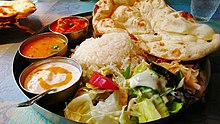
Traditionally, Uttar Pradeshi cuisine consists of Awadhi and Mughlai cuisine, though a vast majority of the state is vegetarian, preferring dal, roti, sabzi, and rice. Pooris and kachoris are eaten on special occasions. Chaat, samosa and pakora, among the most popular snacks in India, originate from Uttar Pradesh.
Uttarakhand

The food from Uttrakhand is known to be wholesome to suit the high-energy necessities of the cold, mountainous region. It is traditionally cooked over wood fire The cuisine mainly consists of food from two different sub regions—Garhwal and Kumaon—though their basic ingredients are the same. A distinctive trait of Kumauni cuisine is the infrequent use of dairy products, as cows from hilly areas do not yield much milk. Both the Garhwal and Kumaon styles make liberal use of ghee, charcoal cooking, lentils or pulses, and bhaatt (rice). To combat the extreme winters and possible exhausting of food, they also use Badi (sun-dried Urad Dal balls) and Mangodi (sun-dried Moong Dal balls) as substitute for vegetables at times. In general, Uttarkhand cuisine resembles that of Uttar Pradesh.
West Bengal

Bengali cuisine is found in the states of Tripura, the Barak Valley of Assam, and West Bengal itself. The cuisine is known for subtle flavours with an emphasis on fish, vegetables, lentils, and rice. Bengal's many rivers, ponds, and lakes produce many kinds of freshwater fish that closely resemble catfish, bass, shad, and mullet. Bengalis prepare fish in many ways, such as steaming, braising, or stewing vegetables and sauces based on coconut milk or mustard. Bengali confectioneries and desserts also distinguish the style, which has perhaps the only multi-course tradition in India similar to those in Western traditions.
Desserts


Many Indian sweets, or mithai, are fried foods made with sugar, milk or condensed milk. Ingredients vary by region; in the eastern part of India, for example, most sweets are based on milk products. See sections or articles on specific regional cuisines for their preferred types of sweets.
Some common Indian sweets and desserts include:
- Barfi: A sweet made of dried milk with ground cashews or pistachios, often served with a thin layer of edible silver foil as decoration
- Chikki: A sweet made out of peanuts and molasses.
- Gulab jamun: A dessert consisting of fried milk balls soaked in sweet syrup, such as rose syrup or honey
- Jalebi: Dough fried in a coil shape dipped in sugar syrup, often taken with milk, tea, yogurt, or lassi
- Kulfi: An Indian ice cream in a variety of flavors such as mango, saffron, or cardamom
- Kheer: A sweet rice pudding, usually made with rice and milk
- Malpoa: A type of pancake, made of wheat or rice flour, deep fried and dipped in sugar syrup
- Rasgulla: A popular sweetmeat, produced by boiling small balls of casein in sugar syrup
- Sandesh: A sweet made from cheese, kneaded with fine ground sugar and molasses
- Shrikhand: A creamy dessert made out of strained yogurt, often served with dried fruits such as mangoes
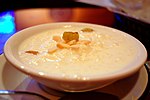


Beverages
Non-alcoholic beverages
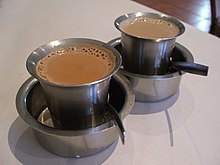

Tea is a staple beverage throughout India; the finest varieties are grown in Darjeeling and Assam. It is generally prepared as masala chai, wherein the tea leaves are boiled in a mix of water, milk, and spices such as cardamom, cloves, cinnamon, and ginger. Coffee is also popular, mostly in South India. Indian filter coffee, or kafee, is also especially popular in South India.
Lassi is a traditional yogurt-based drink in India. It is made by blending yogurt with water or milk and spices. Salted lassi is more common in villages of Punjab and in Porbandar, Gujarat. Traditional lassi is sometimes flavored with ground roasted cumin. Lassi can also be flavored with ingredients such as sugar, rosewater, lemon, strawberry, and saffron.
Sharbat is a sweet cold beverage prepared from fruits or flower petals. It can be served in concentrate form and eaten with a spoon, or diluted with water to create a drink. Popular sharbats are made from plants such as rose, sandalwood, bel, gurhal (hibiscus), lemon, orange, pineapple, and falsa (Grewia asiatica). In Ayurveda, sharbats are believed to hold medicinal value.
Other beverages include nimbu pani (lemonade), chaach, badam doodh (almond milk with nuts and cardamom), and coconut water. Cold drinks unique to southern India include beverages known as "Panner Soda" or "Gholi Soda"—mixtures of carbonated water, rosewater, and sugar—and rose milk.
Alcoholic beverages
Beer
Most beers in India are either lagers (4.8 percent alcohol) or strong lagers (7.8 percent). The Indian beer industry has witnessed steady growth of 10-17 percent per year over the last ten years. Production exceeded 170 million cases during the 2008–2009 financial year. With the average age of the population decreasing[citation needed] and income levels on the rise, the popularity of beer in the country continues to increase while the Indian beer industry has witnessed major changes over the last five years.
Others

Other popular alcoholic drinks in India include fenny, a Goan liquor made from either coconut or the juice of the cashew apple. The state of Goa has registered for a geographical indicator to allow its fenny distilleries to claim exclusive rights to production of liquor under the name "fenny."
Hadia is a rice beer, created by mixing herbs with boiled rice and leaving the mixture to ferment for around a week. It is served cool and is less alcoholic than other Indian country liquors. Chuak is a similar drink from Tripura. Palm wine, locally known as neera, is a sap extracted from inflorescences of various species of toddy palms. Chhaang is consumed by the people of Sikkim and the Darjeeling Himalayan hill region of West Bengal. It is drunk at room temperature in summer, and often hot in cold weather. Chhaang is similar to traditional beer, brewed from barley, millet, or rice.
Eating habits
Indians consider a healthy breakfast (nashta) important. They generally prefer to drink tea or coffee with breakfast, though food preferences vary regionally. North Indian people prefer roti, parathas, and a vegetable dish, accompanied by achar (pickles) and some curd, people of western India prefer dhokla and milk, and South Indians prefer idlis and dosas, generally accompanied by various chutneys.
Lunch in India usually consists of a main dish of rice in the south and east, or whole wheat rotis in the north and west. It typically includes two or three kinds of vegetables, and sometimes items such as kulcha, naan, or parathas. Along with dessert, paan (betel leaves), which aid digestion, are often eaten after lunch in parts of India.
Indian families often gather for "evening breakfast," similar to teatime to talk, drink tea, and eat snacks. Dinner is considered the main meal of the day.
Etiquette

Traditionally, meals in India were eaten while seated either on the floor or on very low stools or cushions. Food is most often eaten with the right hand rather than cutlery. Often roti is used to scoop curry without allowing it to touch the hands. In the wheat-producing north, a piece of roti is gripped with the thumb and middle finger and ripped off while holding the roti down with the index finger. Traditional serving styles vary regionally throughout India. Contact with other cultures has affected Indian dining etiquette; for example, the Indian middle class commonly uses spoons and forks, as is traditional in Western culture.
In South India, cleaned banana leaves, which can be disposed of after the meal, are used for serving food. When hot food is served on banana leaves, the leaves add particular aromas and tastes to the food. Leaf plates are less common today, except on special occasions.
Outside of India
Indian migration has spread the culinary of traditions of the subcontinent throughout the world. These cuisines have been adapted to local tastes, and have also affected local cuisines. Curry's international appeal has been compared to that of pizza.[27] Indian tandoor dishes such as chicken tikka enjoy widespread popularity.[28]
Canada
As in the United Kingdom and the United States, Indian cuisine is widely available in Canada, especially in the cities of Toronto and Vancouver, where the majority of Canadians of South Asian heritage live.
China
Indian food is gaining popularity in China, where there are many Indian restaurants in Beijing, Shanghai, and Shenzhen. Hong Kong alone has more than 50 Indian restaurants, some of which date back to the 1980s. Most of the Indian restaurants in Hong Kong are in Tsim Sha Tsui.
Middle East
Indian cuisine has gained popularity in the Arab world, due to its similarity to and influence on Arab cuisine.[29][dead link] Historically, Indian spices and herbs were among the most sought-after trade commodities, and the spice trade between India and Europe led to the rise and dominance of Arab traders, to such an extent that European explorers such as Vasco da Gama and Christopher Columbus set out to find new trade routes to India, leading to the Age of Discovery.[4]
Southeast Asia

Indian cuisine is very popular in Southeast Asia, due to the strong Hindu and Buddhist cultural influence in the region. Indian cuisine has had considerable influence on Malaysian cooking styles[5] and also enjoys popularity in Singapore.[30][31] There are numerous North and South Indian restaurants in Singapore, mostly in Little India. Singapore is also known for fusion cuisine combining traditional Singaporean cuisine with Indian cuisines. Fish head curry for example, is a local creation. Indian influence on Malay cuisine dates to the 19th century.[32] Other cuisines which borrow inspiration from Indian cooking styles include Filipino, Vietnamese, Indonesian,[33] Thai,[34] and Burmese. The spread of vegetarianism in other parts of Asia is often credited to Indian Hindu and Buddhist practices.[35]
United Kingdom

In 2003, there were as many as 10,000 restaurants serving Indian cuisine in England and Wales alone. According to Britain's Food Standards Agency, the Indian food industry in the United Kingdom is worth 3.2 billion pounds, accounts for two-thirds of all eating out, and serves about 2.5 million British customers every week.[37]
Anglo-Indian restaurants adapt traditional Indian food for British tastes, which are commonly less accustomed to strong spicing. Likely the most famous example of this is chicken tikka masala.
United States
A survey held in 2007 revealed that more than 1,200 Indian food products have been introduced in the United States since 2000.[38] There are numerous Indian restaurants across the US, which vary based on regional culture and climate. North Indian and South Indian cuisines are especially well represented.[39] Most Indian restaurants in the United States serve Americanized versions of North Indian food, which is generally less spicy than its South Indian equivalents.
See also
- Buddhist vegetarianism
- Diet in Hinduism
- Diet in Sikhism
- Indian bread
- Indian Chinese cuisine
- Jain vegetarianism
- List of Indian pickles
- List of Indian snacks
- Marwari Bhojnalaya
- South Asian pickle
References
- ^ Steward, the (pb) by hi. Google Books. ISBN 978-81-250-0325-0. Retrieved 23 June 2009.
- ^ Chandra, Sanjeev; Chandra, Smita (7 February 2008). "The story of desi cuisine: Timeless desi dishes". Toronto Star.
- ^ "Indian food – Indian Cuisine – its history, origins and influences". Indianfoodsco.com. Retrieved 23 June 2009.
- ^ a b Cornillez, Louise Marie M. (Spring 1999). "The History of the Spice Trade in India".
- ^ a b "Nasi, Kari, Biryani & Mee". Veg Voyages. Retrieved 23 June 2009.
- ^ "Asia Food Features". Asiafood.org. Retrieved 23 June 2009.
- ^ "Chapter 17, Verse 8,9,10". Bhagavad-Gita. Retrieved 31 August 2011.
- ^ "Chhattisgarh Cuisine in India". India9.com. 7 June 2005. Retrieved 7 February 2011.
- ^ "Goa – Daman, Beach, Access, accommodation/stay, shopping options". Travelmasti.com. Retrieved 7 February 2011.
- ^ "Diu Island Cuisine". Mapsofindia.com. Retrieved 7 February 2011.
- ^ "Cuisine of Haryana – Recipes Wiki". Recipes.wikia.com. 24 January 2011. Retrieved 7 February 2011.
- ^ "Food of Haryana, Cuisine of Haryana, Famous Haryana Food, Recipes of Haryana, Haryana Food". Richindianculture.com. Retrieved 7 February 2011.
- ^ Anand, Karen. "Treats from the Valley". The Times of India.
{{cite web}}: Italic or bold markup not allowed in:|publisher=(help) - ^ "Culture of Lakshadweep – India". India.wikia.com. Retrieved 7 February 2011.
- ^ "Uni Crystal Holidays Pvt. Ltd". Unicrystalholidays.com. Retrieved 7 February 2011.
- ^ "Cuisines of North East India".
- ^ Ritter, Peter (22 July 2007). "6,000 Years of Red Hot Chili Peppers". Time. Retrieved 16 May 2012.
- ^ "Food in Mizoram". Mapsofindia.com. Retrieved 7 February 2011.
- ^ "Mizo Cuisine in India". India9.com. 7 June 2005. Retrieved 7 February 2011.
- ^ Bhandari Laveesh (1 September 2009). Indian States At A Glance 2008-09: Performance, Facts And Figures - North-East And Sikkim. Pearson Education India. pp. 48–. ISBN 978-81-317-2348-7. Retrieved 31 May 2012.
- ^ "Pondicherry Cuisine". Mapsofindia.com. Retrieved 7 February 2011.
- ^ Tarla Dalal (15 June 2007). Punjabi Khana. Sanjay & Co. pp. 6–. ISBN 978-81-89491-54-3. Retrieved 31 May 2012.
- ^ "Care for some Sindhi savouries?". Dnaindia.com. 5 November 2010. Retrieved 7 February 2011.
- ^ "Sindhi Cuisine". Sindhunagar.com. Retrieved 7 February 2011.
- ^ Yoder, Candie. "Masala Chai".
- ^ {{cite news |url=http://www.hindu.com/2008/03/30/stories/2008033058640200.htm |title=As coffee gets popular |first=M. Soundariya |last=Preetha | location=[[Chennai |work=The Hindu |date=30 March 2008}}
- ^ Collingham, Lizzie (1 February 2006). "Curry". The New York Times Book Review. Retrieved 5 May 2010.
- ^ "Tandoori Village Restaurant Brisbane". AsiaRooms.com.
- ^ "Indian Cuisine Is Popular as It's Close to Arabic Food". Arab News. 16 June 2006.
{{cite web}}:|first=missing|last=(help); Unknown parameter|Last=ignored (|last=suggested) (help) - ^ "Indian food gains popularity during Chinese New Year". 20 February 2007.
- ^ Then, Viviane. "Go India: Curry, my love?".
- ^ "About Food in Malaysia".
- ^ Freeman, Nancy. "Ethnic Cuisine: Indonesia".
- ^ "Thai Kitchen in East Lansing, Michigan".
- ^ Corum, Ann Kondo (2000). Ethnic Foods of Hawai'i. Bess Press. p. 174. ISBN 978-1-57306-117-9.
- ^ "Robin Cook's chicken tikka masala speech". London: The Guardian. 19 April 2001. Retrieved 25 February 2002-02-25.
{{cite news}}: Check date values in:|accessdate=(help); Italic or bold markup not allowed in:|publisher=(help) - ^ "Food Standards Agency – Curry factfile".
- ^ Bhide, Monica (24 January 2007). "Tikka in No Time". The Washington Post.
- ^ "Indian restaurants in USA". Immihelp.com. Retrieved 6 September 2010.
Bibliography
- Pat Chapman India: Food & Cooking, New Holland, London — ISBN 978-1-84537-619-2 (2007)
